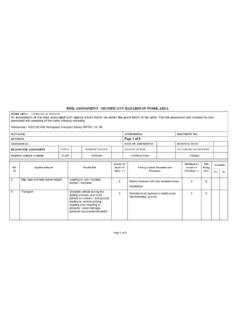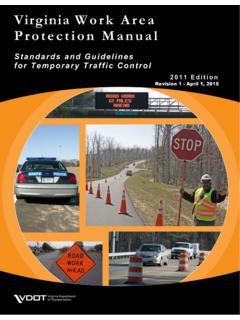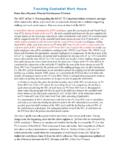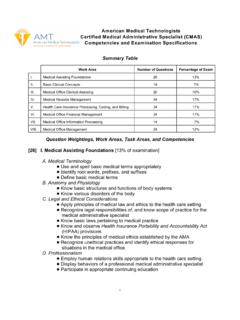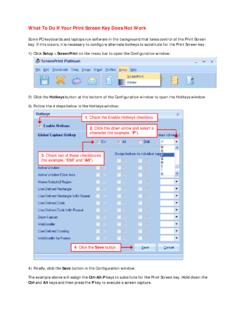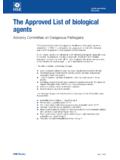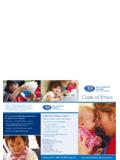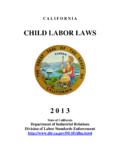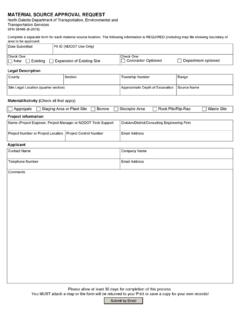Transcription of Inspection and reports - Health and Safety Executive
1 HSE information sheet Inspection and reports Construction Information Sheet No 47(rev1) Introduction reports This information sheet sets out the specific The result of an Inspection must be recorded and requirements for: retained. the Inspection of: If an Inspection is of: - excavations of any depth; an excavation, cofferdam or caisson; or a working platform which is 2 metres or above in-cofferdams and caissons; height and is undertaken after installation or - existing places of work (which prevent falls assembly or to comply with the seven day Inspection regime;without the addition or use of other equipment eg permanent guard rails on a the competent person must: flat roof).
2 Complete the Inspection report before the end of - work platforms (eg scaffolds, mobile the working period; and platforms); - collective fall arrest systems (eg nets, airbags, soft landing systems); provide a copy of the report to the person for whom the Inspection was carried out within 24 hours. -personal fall protection systems (eg work The person receiving the report must: positioning, rope access, work restraint and fall arrest systems); keep it at the site where the Inspection was carried out until construction work is completed; - ladders and stepladders; and the reports which have to be made following keep it at an office for a further three months.
3 Inspections. Page 2 contains a suggested report form. You do not have to use this form. However, your record mustInspections include the following information: The information in Table 1 outlines what must be Name and address of the person for whom the checked, inspected or examined under the Inspection was carried out. Construction ( Health , Safety and We l f a r e ) Regulations 1996, the Lifting Operations and Lifting Location of the place of work or work equipment Equipment Regulations 1998 and the work at Height inspected. Regulations 2005. It includes the timing and frequency of those inspections.
4 Description of the place of work or work equipment inspected. Inspections should only be carried out by a competent person. This is someone with the Date and time of the Inspection . experience, knowledge and appropriate qualifications Details of any matter identified that could give risenecessary to enable them to identify any risks that are present and decide upon the measures required to a risk to the Health or Safety of any person. to control those risks. Details of any action taken as a result of any matter identified. Stop work if the Inspection shows it is not safe to continue.
5 Details of any further action considered necessary. Name and position of the person making the report. 1 Inspection REPORT 1. Name and address of person for whom Inspection was carried out. 2. Site address. 3. Date and time of Inspection . 4. Location and description of place of work or work equipment inspected. 5. Matters which give rise to any Health and Safety risks. 6. Can work be carried out safely? 7. If not, name of person informed. Y / N 8. Details of any other action taken as a result of matters identified in 5 above. 9. Details of any further action considered necessary.
6 10. Name and position of person making the report. 11. Date and time report handed over. 12. Name and position of person receiving report. 2 3 Table 1 Timing and frequency of checks, inspections and examinations Place of work or work equipment Timing and frequency of checks, inspections and examinations Inspect before work at the start of every shift (see note 1) Inspect after any event likely to have affected its strength or stability Inspect after accidental fall of rock, earth or other material Inspect after installation or assembly in any position (see notes 2 and 3)
7 Inspect at suitable intervals Inspect after exceptional circumstances which are liable to jeopardise the Safety of work equipment Inspect at intervals not exceeding 7 days (see note 3) Check on each occasion before use (REPORT NOT REQUIRED) LOLER Thorough Examination (if work equipment subject to LOLER) (see note 4) Excavations which are supported to prevent any person being buried or trapped by an accidental collapse or a fall or dislodgement of material Cofferdams and caissons The surface and every parapet or permanent rail of every existing place of work at height Guard rails, toe boards, barriers and similar collective means of fall protection Scaffolds and other working platforms (including tower scaffolds and MEWPs)
8 Used for construction work and from which a person could fall more than 2m All other working platforms Collective safeguards for arresting falls (eg nets, airbags, soft landing systems) Personal fall protection systems (including work positioning, rope access, work restraint and fall arrest systems) Ladders and stepladders Notes 1 Although an excavation must be inspected at the start of every shift, only one report is needed in any seven-day period. However, if something happens to affect its strength or stability, and/or an additional Inspection is carried out, a report must then be completed.
9 A record of this Inspection must be processed as outlined on page 1. 2 Installation means putting into position and assembly means putting together. You are not required to inspect and provide a report every time a ladder, tower scaffold or mobile elevated work platform (MEWP) is moved on site or a personal fall protection system is clipped to a new location. 3 An Inspection and a report is required for a tower scaffold or MEWP (used for construction work and from which a person could fall 2 metres) after installation or assembly and every seven days thereafter, providing the equipment is being used on the same site.
10 A record of this Inspection must be processed as outlined on page 1. If a tower scaffold is reassembled rather than simply moved, then an additional, pre-use Inspection and report is required. It is acceptable for this Inspection to be carried out by the person responsible for erecting the tower scaffold, providing they are trained and competent. A visible tag system, which supplements Inspection records as it is updated following each pre-use Inspection , is a way of recording and keeping the results until the next Inspection . 4 All work equipment subject to LOLER regulation 9, thorough examination and Inspection requirements, will continue to be subject to LOLER regulation 9 requirements.










